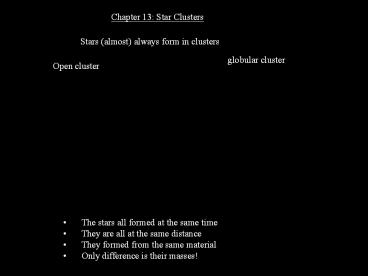Chapter 13: Star Clusters - PowerPoint PPT Presentation
Title:
Chapter 13: Star Clusters
Description:
Chapter 13: Star Clusters Stars (almost) always form in clusters globular cluster Open cluster The stars all formed at the same time They are all at the same distance – PowerPoint PPT presentation
Number of Views:226
Avg rating:3.0/5.0
Title: Chapter 13: Star Clusters
1
Chapter 13 Star Clusters
Stars (almost) always form in clusters
globular cluster
Open cluster
- The stars all formed at the same time
- They are all at the same distance
- They formed from the same material
- Only difference is their masses!
2
h Chi Persei Double Cluster in Perseus
3
Messier 35 and NGC2158 open clusters of
different ages
4
Pleiades
- Open clusters
- Contain lt 1000 stars
- Loosely gravitationally bound together
- Younger than globular (some still contain O and B
stars) - More enriched in heavy elements (Population I
stars)
5
Messier 50 An open cluster of stars
6
Open clusters that have become gravitationally
unbound are stellar associations. If they
continue to have similar proper motion, this is a
moving group.
Ursa Major moving group
7
- globular clusters
- Contains 1000-106 stars
- Extremely old billions of years
- Population II (low in heavy elements)
8
Globular cluster M2
He who cannot see gravity at work here has no
soul. - Richard Feynman
9
HD Diagram for star clusters only difference is
mass
10
Isochrones Lines of constant age for stars of
different masses
11
M.S. LIFETIME for STAR at TURNOFF AGE of
CLUSTER
12
Star cluster website
13
(No Transcript)
14
- Star clusters are useful to
- Verify stellar evolution models
- Determine distances to nearby galaxies
- Determine chemical composition of universe in the
very distant past
15
(No Transcript)

